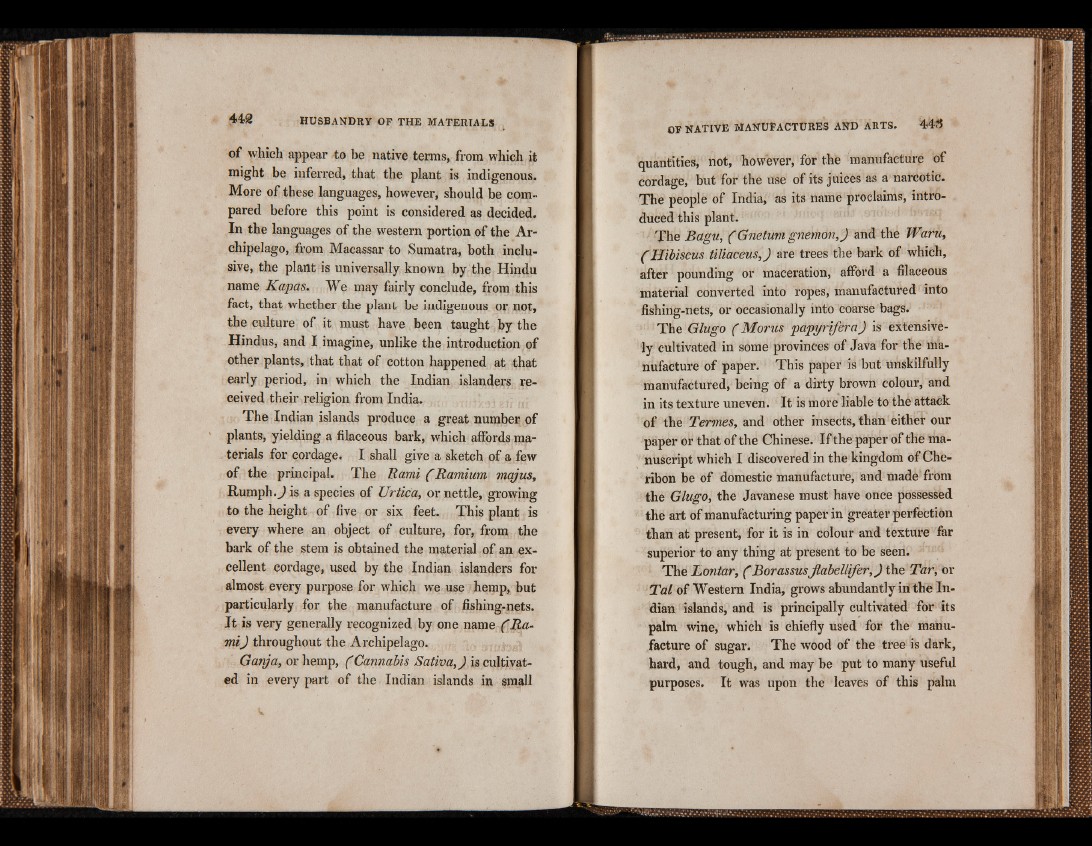
of which appear -to be native terms, from which it
might be inferred, that the plant is indigenous.
More of these languages, however, should be compared
before this point is considered as decided.
In the languages of the western portion of the Archipelago,
from Macassar to Sumatra, both inclusive,
the plant is universally known by the Hindu
name Kapas. We may fairly conclude, from this
fact, that whether the plant be indigenous or not,
the culture of it must have been taught by the
Hindus, and I imagine, unlike the introduction of
other plants, that that of cotton happened at that
early period, in which the Indian islanders received
their religion from India.
The Indian islands produce a great number of
plants, yielding a filaceous bark, which affords materials
for cordage. I shall give a sketch of a few
of the principal. The Rami ( Ramium majus,
Rumph.J is a species of Ur tic a, or nettle, growing
to the height of five or six feet. This plant is
every where an object of culture, for, from the
bark of the stem is obtained the material of an excellent
cordage, used by the Indian islanders for
almost every purpose for which we use hemp, but
particularly for the manufacture of fishing-nets.
I t is very generally recognized by one name (R a miJ
throughout the Archipelago.
Ganja, or hemp, ( Cannabis Saliva, J is cultivated
in every part of the Indian islands in small
quantities, not, however, for the manufacture of
cordage, but for the use of its juices as a narcotic.
The people of India, as its name proclaims, introduced
this plant.
The Bagu, (Gnetum gnemon,) and the Warn,
( Hibiscus tiliaceus,) are trees the bark of which,
after pounding or maceration, afford a filaceous
material converted into ropes, manufactured into
fishing-nets, or occasionally into coarse bags.
The Glugo ( Morus papyrifera) is extensively
cultivated in some provinces of Java for the manufacture
of paper. 1 This paper is but unskilfully
manufactured, being of a dirty brown colour, and
in its texture uneven. It is more liable to the attack
of the Termes, and other insects, than either our
paper or that of the Chinese. If the paper of the manuscript
which I discovered in the kingdom of Che-
ribon be of domestic manufacture, and made from
the Glugo, the Javanese must have once possessed
the art of manufacturing paper in greater perfection
than at present, for it is in colour and texture far
superior to any thing at present to be seen.
The Lontar, ( Borassus jlabellifer, ) the Tar, or
Tal of Western India, grows abundantly in the Indian
islands, and is principally cultivated for its
palm wine, which is chiefly used for the manufacture
of sugar. The wood of the tree is dark,
hard, and tough, and may be put to many useful
purposes. It was upon the leaves of this palm